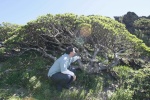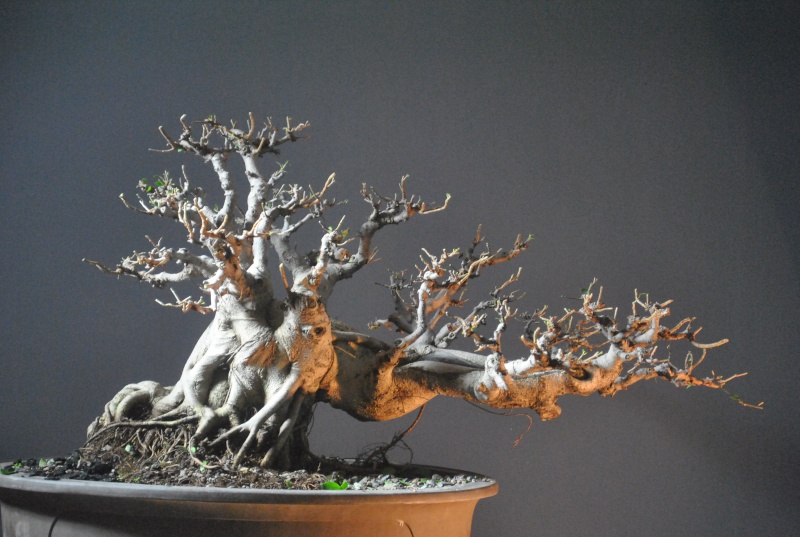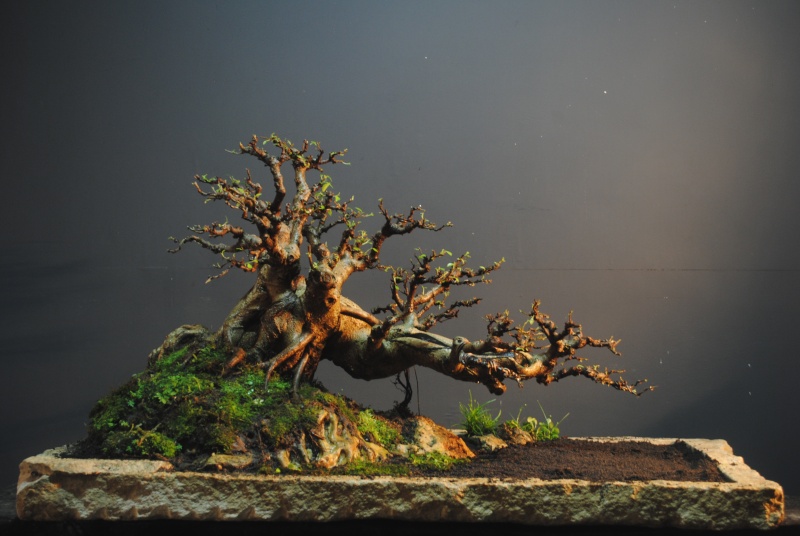Trying to rectify
+17
Fore
elmermateo
reg-i
jrodriguez
Hans van Meer.
RYUGA
Rob Kempinski
kauaibonsai
Robert Steven
bucknbonsai
Sam Ogranaja
my nellie
Poink88
moyogijohn
Gina
Ebbtide
Andre Beaurain
21 posters
Page 3 of 3
Page 3 of 3 •  1, 2, 3
1, 2, 3
 Re: Trying to rectify
Re: Trying to rectify
re. above:
every species callouses (?) differently - i have maples (palmatum), juniper and white pine that heal flat when the prune is cut to a hollowed shallow. Tridents i carve a little deeper to get a neat heal but beech are making swollen heals on all cuts so i'm at a loss with them!
cheers Marcus
every species callouses (?) differently - i have maples (palmatum), juniper and white pine that heal flat when the prune is cut to a hollowed shallow. Tridents i carve a little deeper to get a neat heal but beech are making swollen heals on all cuts so i'm at a loss with them!
cheers Marcus

marcus watts- Member
 Re: Trying to rectify
Re: Trying to rectify
marcus, thank you for the response. Im jealous that you can get your beech to grow enough to form a callous. It seems to me that once american beech is removed from the wild and placed in a pot (even an appropriate sized growing out pot), they just stop growing. Ive had some for 6 years now that grow a full dense canopy of foliage every year and yet trunk caliper has not changed a single bit, hence wounds arnt covering at all. Ive even noticed that american hornbeam acts similar but not quite as bad as the beech, and thats even if they are placed immediately into a rich loamy soil in the vegetable garden for several years.

bucknbonsai- Member
 Re: Trying to rectify
Re: Trying to rectify
bucknbonsai wrote:marcus, thank you for the response. Im jealous that you can get your beech to grow enough to form a callous. It seems to me that once american beech is removed from the wild and placed in a pot (even an appropriate sized growing out pot), they just stop growing. Ive had some for 6 years now that grow a full dense canopy of foliage every year and yet trunk caliper has not changed a single bit, hence wounds arnt covering at all. Ive even noticed that american hornbeam acts similar but not quite as bad as the beech, and thats even if they are placed immediately into a rich loamy soil in the vegetable garden for several years.
Hi, I get the beech callousing over ok (European and japanese), but in a bulbous way - ugly and lumpy - can Jay comment on American beech?
I think the key may be active growth in the branch directly above the wound rather than all the tree, but that is a bit of a theory to be honest
cheers Marcus

marcus watts- Member
 Re: Trying to rectify
Re: Trying to rectify
jrodriguez wrote:Robert Steven wrote:jrodriguez wrote:
Remember, Chinese culture is millenary. The concept of generations is quite important and is regarded highly. The is transported to Pentsai/bonsai. It is what truly represents age in a composition. For example, we often see a mighty trunk bonsai with skinny branches. In the Chinese perspective, there is a serious generational gap, as the oldest generation is coexisting side by side with the youngest and without the middle generations. By combining lignan techniques with positional wire, you will achieve a product that does not leave generational gaps.
Jose Luis
I have never heart about this generation gap philosophy in China..I wonder this is just an excuse for being impatient to grow the thicker branches, knowing that Chinese likes massive huge bonsai, and it takes lifetime to obtain the proportional structure... At least I won't put this in my coming book about penjing...
Robert,
Well, this has been manifested to me many times in Taiwan. Often, the topic comes up when we talk about quickly ramified bonsai. This concept is not that different from your descriptions and philosophy regarding trees that revert to an inmature state. As you statet in your book, it takes some time until the tree becomes mature again. Perhaps it was explained to me using a family tree as an analogy. If so, it is a very good way of explaining the concept.
Perhaps you should reconsider this fact and try to incorporate it, using your own perspective in your upcoming book. It is a topic that has seldom been talked about.
Warm regards,
Jose Luis
Thanks Jose.
As explained very details in my book "Mission of Transformation", unproportional size feature between branches and trunk should refer to the "Leonardo Theory". The unpropotional condition will be considered as immature state if the whole tree design is portraying a "normal condition" tree because the Leonardo Theory should be applied. But if the unproportional condition is on a "transformed tree" design, then this condition will not be considered as immature because those branches might never reached the proportional state, and it is not neccessary so providing we can well convey this message through the designing skill..the tree will talk by itself for the whole chronicle.
This below bonsai will be considered as immature because we can tell that the artist is trying to design a big tree in "normal" condition. In nature, such a mature tree should follow the Leonardo Theory with the proportional features.

But this below bonsai, although the size difference between the trunk and the branches is more than the first picture, but no body care about the tapering, we don't feel the unproportion is disturbing because the whole design is well conveying a tree which has gone through a transformation process to a new form, which is different from its initial shape..and in this stage, the Leonardo Theory is not valid because what we see as the first branch here might be the third or fourth branch before..or a new branch grew during the transformation.

Re. My coming book "The Five Schools of Chinese Penjing". There will be no personal perspective on this book, different from my last 2 books. This book is based on authentic sources about Chinese penjing through deep and careful research, discussion with Chinese masters. The objective is to share insight information about Chinese penjing which so far, not available in foreign languages. However, in certain extend, I will use my "own" language to ilustrate the message because Chinese language can not be translated when it comes to aesthetic aspect; that's why Chinese penjing, like its other art form, have been widely misunderstood.
Thank you Jose, nyway....
Last edited by Robert Steven on Sat Feb 25, 2012 2:36 pm; edited 2 times in total (Reason for editing : mistype)

Robert Steven- Member
 Re: Trying to rectify
Re: Trying to rectify
bucknbonsai wrote:jose, this might seem like a stupid question but is there any ratio of wound size to how deep it should be? When removing large limbs there is no knob cutters big enough so I often grind down the area as a concavity, All the books say make it concave but how do you know "HOW" concave to make it, to produce a situation that the bark heals as fast as possible without to large of a scar. Should wounds on thinner barked trees be less concave than tridents for example? thanks.
Asking questions is not stupid, it is wise!
There is a lot of discrepancy in terms of levying the cut flat or making it concave. Experience has taught me that, at least in tropical and subtropical trees, that it is better to leave the surface of the cut flat and with no concavity. Let me explain. I have tried both methods and have found out that in those that are reduced, the new tissue rolls up to a certain point, but stops a the point where the concavity is deeper. In this that are left flat, the tissue has better surface area to grow on and do so until the scar completely callouses.
Again, this is my experience. I have also tried this on Taiwan trident with good results. As far as buna (beech) and other temperate trees, I cannot vouch for.
Regards,
Jose Luis

jrodriguez- Member
 Re: Trying to rectify
Re: Trying to rectify
bucknbonsai wrote:jose, this might seem like a stupid question but is there any ratio of wound size to how deep it should be? When removing large limbs there is no knob cutters big enough so I often grind down the area as a concavity, All the books say make it concave but how do you know "HOW" concave to make it, to produce a situation that the bark heals as fast as possible without to large of a scar. Should wounds on thinner barked trees be less concave than tridents for example? thanks.
Asking questions is not stupid, it is wise!
There is a lot of discrepancy in terms of leaving the cut flat or making it concave. Experience has taught me that, at least in tropical and subtropical trees, it is better to leave the surface of the cut flat and with no concavity. Let me explain. I have tried both methods and have found out that in those that are reduced, the new tissue rolls up to a certain extent, but stops at the point where the concavity is deeper. In those that are left flat, the tissue has better surface area to grow on and do so until the scar completely callouses.
Again, this is my experience. I have also tried this on Taiwan trident with good results. As far as buna (beech) and other temperate trees, I cannot vouch for.
Regards,
Jose Luis

jrodriguez- Member
 Re: Trying to rectify
Re: Trying to rectify
jrodriguez wrote:[quote="
There is a lot of discrepancy in terms of levying the cut flat or making it concave. Experience has taught me that, at least in tropical and subtropical trees, that it is better to leave the surface of the cut flat and with no concavity. Let me explain. I have tried both methods and have found out that in those that are reduced, the new tissue rolls up to a certain point, but stops a the point where the concavity is deeper. In this that are left flat, the tissue has better surface area to grow on and do so until the scar completely callouses.
Again, this is my experience. I have also tried this on Taiwan trident with good results. As far as buna (beech) and other temperate trees, I cannot vouch for.
Regards,
Jose Luis
Very informative. never thought cutting it dead flat or concave would make any difference.
Thanks Jose Luis.
regards,
jun
Guest- Guest
 Re: Trying to rectify
Re: Trying to rectify
Hi June.
I have some pictures later. Hope it can help you. So close to my style of Lingnan. Because my camera is damaged, can not give you much more.



I have some pictures later. Hope it can help you. So close to my style of Lingnan. Because my camera is damaged, can not give you much more.
Ẩn khách- Member
 Re: Trying to rectify
Re: Trying to rectify
Jun,
Ever thought about stripping bark from the bottom of the long bottom branch planting it on a downward angle and re creating it as a raft style penjing???
Ever thought about stripping bark from the bottom of the long bottom branch planting it on a downward angle and re creating it as a raft style penjing???

CraftyTanuki- Member
Page 3 of 3 •  1, 2, 3
1, 2, 3
Page 3 of 3
Permissions in this forum:
You cannot reply to topics in this forum|
|
|












